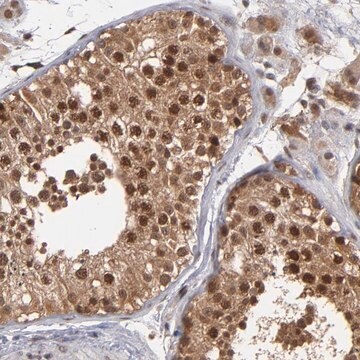CLL1220
Safe Harbor Landing Pad Cell Line A549 Cancer Cells
human male lung (Source Disease: Carcinoma)
Autenticatiper visualizzare i prezzi riservati alla tua organizzazione & contrattuali
About This Item
Codice UNSPSC:
41106514
NACRES:
NA.81
Prodotti consigliati
product name
Safe Harbor Landing Pad Cell Line A549 Cancer Cells,
Origine biologica
human male lung (Source Disease: Carcinoma)
Livello qualitativo
Forma fisica
frozen liquid (Vial of Frozen Cells)
Modalità di accrescimento
Adherent
tecniche
cell culture | mammalian: suitable
Condizioni di spedizione
dry ice
Temperatura di conservazione
−196°C
Descrizione generale
The STR profile of this cell line matches that of its parental cell line ATCC® Catalog No. CCL-185a. A549 is a human lung carcinoma cell line isolated in 1972 from a lung tumor of a male patient suffering from carcinoma.
Descrizione della linea cellulare
These cells are a human lung carcinoma cell line isolated from a lung tumor of a 58-year old male suffering from carcinoma. The cells possess a hypotriploid karyotype and express EGFR and mutant KRAS.
Applicazioni
This product is a human A549 adenocarcinoma cell line in which a landing pad cassette has been integrated into the AAVS1 safe harbor locus using CompoZr®Zinc Finger Nuclease technology. The mKATE2 fluorescence gene was integrated following the EF1a promoter and flanked by unique Cre-lox sites. The design of this landing pad cassette allows for easy, fast, and affordable genetic modification using Cre recombinase. mKATE2 can easily be exchanged for a payload of the user′s choice using Cre recombinase and a targeting vector with appropriate lox sites. Cells can then be sorted via fluorescence-activated cell sorting (FACS) for loss of mKATE2 expression as a surrogate for successful integration of the targeting vector. Approximately 7-10 days are required for loss of the mKATE2 signal in successfully targeted cells. See technical bulletin for detailed protocols.
Caratteristiche e vantaggi
These cells contain the mKATE2 fluorescence gene flanked by unique Cre-lox sites inserted in the AAVS1 safe harbor gene. These A549 cells are adherent with a doubling time of approximately 22 hours.
Qualità
Tested for Mycoplasma, bacterial and fungal content, post-freeze viability, short terminal repeat (STR) analysis for cell line identification.
Terreno di coltura
RPMI modified to contain 2mM L-glutamine, 10mM HEPES, 1mM sodium pyruvate, and 1500mg/L sodium bicarbonate. Add 10% FBS(Catalog Number F2442).
Note legali
ATCC is a registered trademark of American Type Culture Collection
CompoZr is a registered trademark of Merck KGaA, Darmstadt, Germany
Codice della classe di stoccaggio
10 - Combustible liquids
Classe di pericolosità dell'acqua (WGK)
WGK 3
Punto d’infiammabilità (°F)
Not applicable
Punto d’infiammabilità (°C)
Not applicable
Certificati d'analisi (COA)
Cerca il Certificati d'analisi (COA) digitando il numero di lotto/batch corrispondente. I numeri di lotto o di batch sono stampati sull'etichetta dei prodotti dopo la parola ‘Lotto’ o ‘Batch’.
Possiedi già questo prodotto?
I documenti relativi ai prodotti acquistati recentemente sono disponibili nell’Archivio dei documenti.
Kimi Araki et al.
Nucleic acids research, 30(19), e103-e103 (2002-10-05)
The Cre-lox system is an important tool for genetic manipulation. To promote integrative reactions, two strategies using mutant lox sites have been developed. One is the left element/right element (LE/RE)-mutant strategy and the other is the cassette exchange strategy using
Huseyin Tas et al.
PloS one, 10(9), e0136963-e0136963 (2015-09-04)
We describe an optimized system for the easy, effective, and precise modification of the Escherichia coli genome. Genome changes are introduced first through the integration of a 1.3 kbp Landing Pad consisting of a gene conferring resistance to tetracycline (tetA)
Zhong-Wei Du et al.
Stem cells (Dayton, Ohio), 27(5), 1032-1041 (2009-05-06)
To circumvent the silencing effect of transgene expression in human embryonic stem cells (hESCs), we employed the Cre recombination-mediated cassette exchange strategy to target the silencing-resistant site in the genome. We have identified new loci that sustain transgene expression during
Il team dei nostri ricercatori vanta grande esperienza in tutte le aree della ricerca quali Life Science, scienza dei materiali, sintesi chimica, cromatografia, discipline analitiche, ecc..
Contatta l'Assistenza Tecnica.








